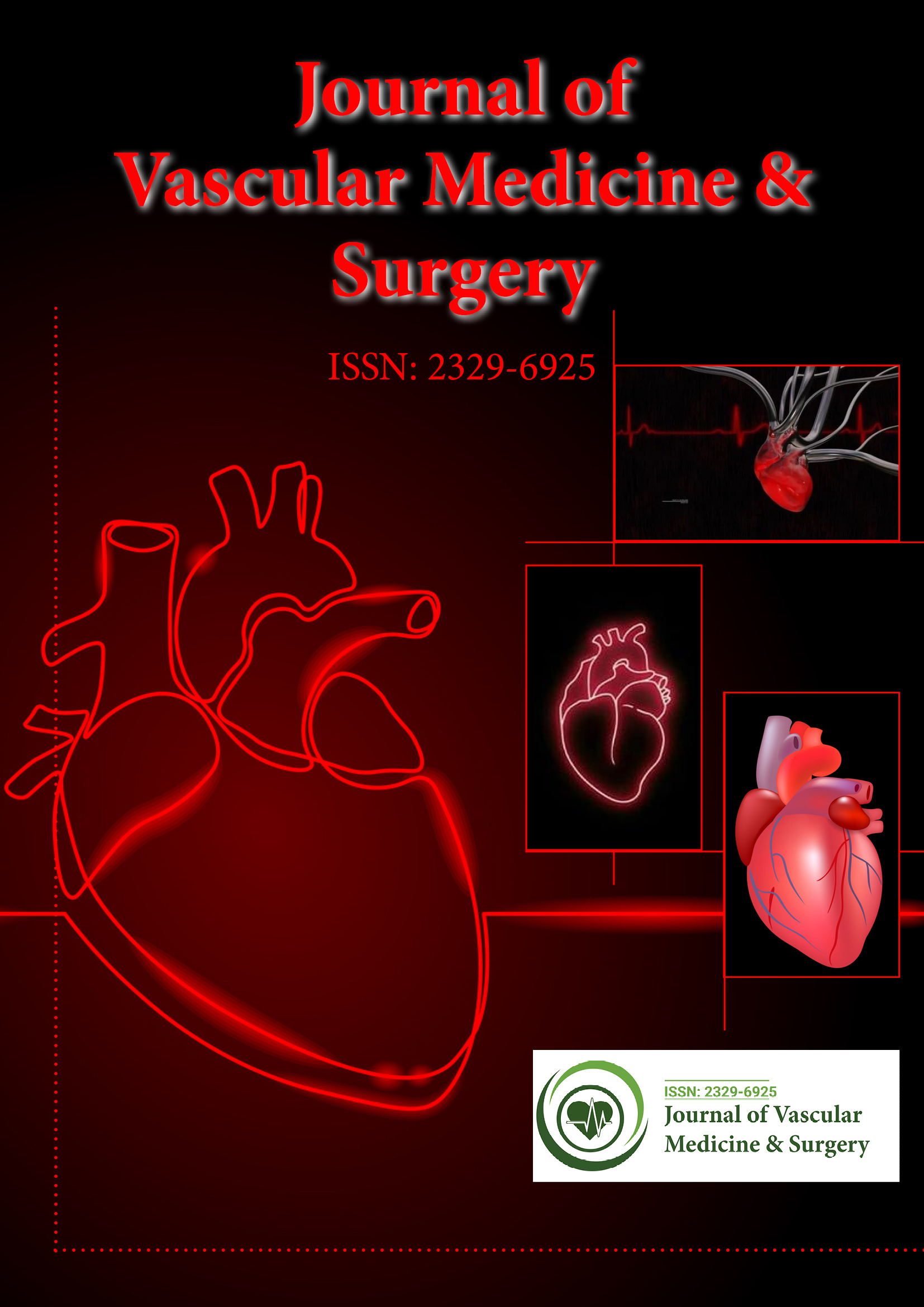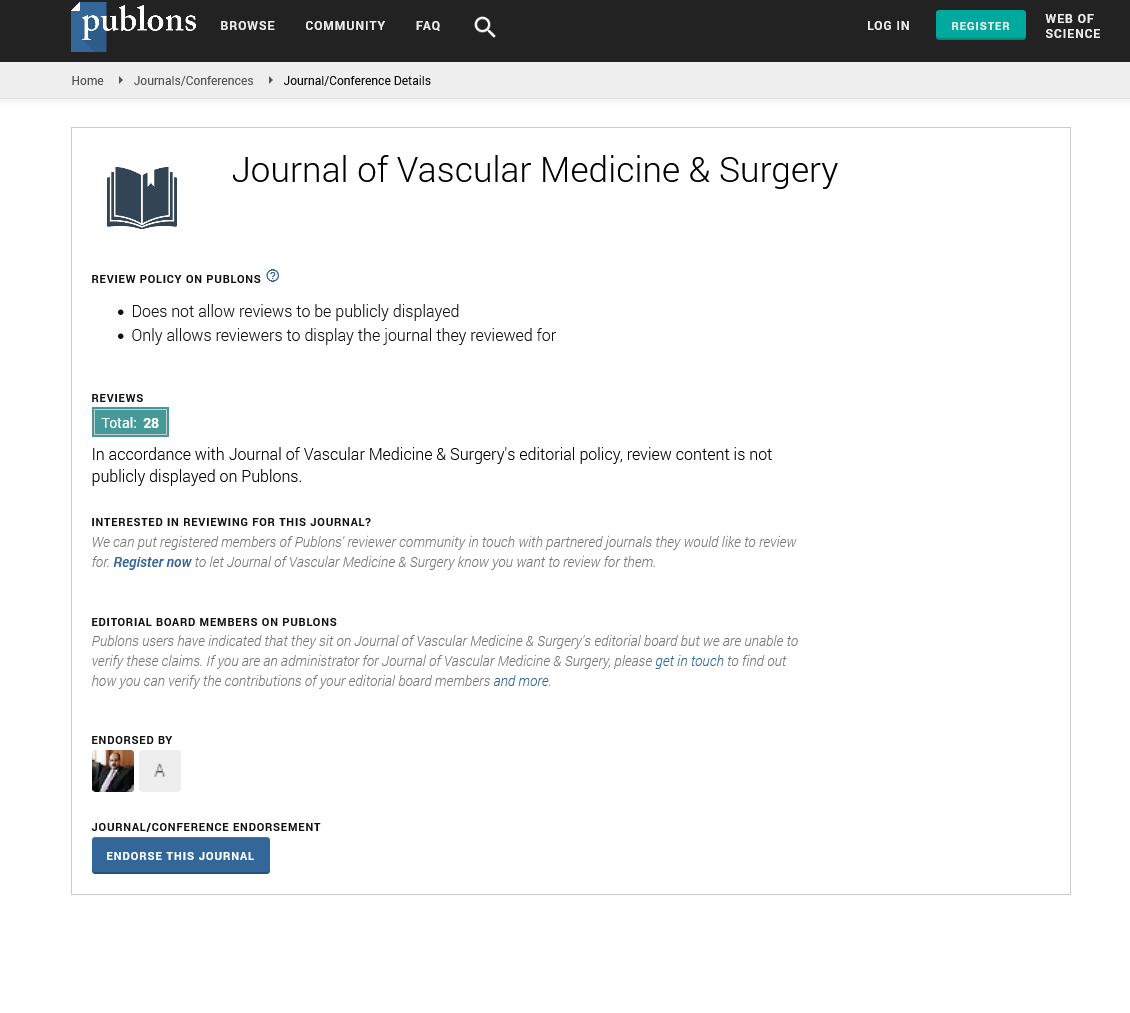Indexed In
- Open J Gate
- Academic Keys
- RefSeek
- Hamdard University
- EBSCO A-Z
- OCLC- WorldCat
- Publons
- Euro Pub
- Google Scholar
- SHERPA ROMEO
Useful Links
Share This Page
Journal Flyer

Open Access Journals
- Agri and Aquaculture
- Biochemistry
- Bioinformatics & Systems Biology
- Business & Management
- Chemistry
- Clinical Sciences
- Engineering
- Food & Nutrition
- General Science
- Genetics & Molecular Biology
- Immunology & Microbiology
- Medical Sciences
- Neuroscience & Psychology
- Nursing & Health Care
- Pharmaceutical Sciences
Commentary Article - (2022) Volume 0, Issue 0
Peripheral Vascular Disease: Risk Factors and Treatment
Leonardo Akbar*Received: 03-Nov-2022, Manuscript No. JVMS-22-19315; Editor assigned: 07-Nov-2022, Pre QC No. JVMS-22-19315 (PQ); Reviewed: 21-Nov-2022, QC No. JVMS-22-19315; Revised: 28-Nov-2022, Manuscript No. JVMS-22-19315 (R); Published: 08-Dec-2022, DOI: 10.35248/2329-6925.22.S12.488
Description
Vascular Disease (VD) is a group of disorders that affect the blood vessels, arteries and veins of the body's circulatory system. A subsection of coronary heart disease is a vascular disease. Disorders in either vast blood vessel network can result in a wide range of health issues.
Types of vascular disease
There are different types of vascular disease, and the symptoms and signs differ based on the disorder. These are some examples.
Erythromelalgia: A rare peripheral vascular disease characterized by burning sensation, increased temperature, skin redness, and swelling in the hands and feet. A 77-year-old woman has erythromelalgia.
Peripheral artery disease: Peripheral artery disease occurs when atheromatous plaques accumulate in the arteries that supply blood to the arms and the legs, reducing or blocking the arteries.
Renal artery stenosis: Reducing of the renal arteries, which carry blood from the aorta to the organs.
Buerger's disease: Small blood vessel inflammation and swelling cause the vessels to narrow and become prevented by blood clots.
Raynaud's disease: An infrequent peripheral vascular condition that causes muscle contractions of the peripheral blood vessels in the hands and feet when a person is experiencing stress.
Disseminated intravascular coagulation: Blood clotting is widely activated in smaller blood vessels.
Cerebrovascular disease: A group of vascular diseases that have an effect on brain function.
Mechanism of vascular disease
Vascular disease is a pathological condition that impacts the large and medium muscular arteries that is caused by dysfunction of endothelial cells. Endothelial cells become active as a result of factors such as pathogenic organisms, metabolized LDL particles, and other inflammatory stimulation. The process can cause the vessel wall to increase in size, resulting in the development of a plaque composed of increasing smooth muscle cells, macrophages, and lymphocytes. The plaque prevents blood flow, reducing the amount of oxygen and nutrients that reach specific organs. This plaque can also dissolve, resulting in the development of thrombus.
Vasculitis
A medicine, an infectious disease, or an unknown cause can lead the blood vessels to become swollen and painful. This can make it more difficult for blood to flow through the blood vessels. Rheumatological conditions or connective tissue disease are sometimes associated with this vessels. Aneurysms can also be caused by vasculitis.
Causes and risk factors of vascular disease
Vascular disease causes can include: Coronary artery disease is the accumulation of plaque in the arteries. A mass of particles (embolus) or a blood clot blocks coronary arteries (thrombus). Vasculitis is an inflammation and trauma or multiple injuries.
Some factors can increase the chances of developing vascular disease, which includes: Diabetes, family history of cardiovascular events, heart attack, or pulmonary embolism. Gender (Men are more vulnerable than women), blood pressure is high. High in sugar levels, such as cholesterol and triglycerides. Requires improvement physical activity, obesity or being overweight and smoking and stress.
Vascular disease treatment
Many vascular diseases can be treated with simple lifestyle changes, such as: A healthy diet can assist the lower blood sugar or cholesterol levels, exercise regularly, tobacco inhibition, stress control. People may require the following medications: Blood pressure medications, medication for high cholesterol, if the disease is severe, and person may require a medical procedure such as an angioplasty, in which the doctor expands or prevents a blood vessel.
Vascular disease prevention
Sometimes person haven't been diagnosed with vascular disease, producing some of these lifestyle changes can help stay healthy. Eat a nutritious diet, exercise regularly, and prevent smoking.
Citation: Akbar L (2022) Peripheral Vascular Disease: Risk Factors and Treatment. J Vasc Surg. S12:488.
Copyright: © 2022 Akbar L. This is an open access article distributed under the terms of the Creative Commons Attribution License, which permits unrestricted use, distribution, and reproduction in any medium, provided the original author and source are credited.

